Yesterday we transplanted the seedlings that I so lovingly started (using LED lights hanging on a drying rack over seeds planted in egg cartons). Less than half of the spinach came up, and only one basil, but both patty pan squashes looked pretty good. None of the watermelons started, and the one tomato that came out didn't end up transplanted, because we got a free huge tomato of the same variety two weeks ago at Magic Garden.
The garden now contains:
1) Cassie, the pomegranate bush, who has produced exactly one fruit in the two years we've had her. There are watermelon seeds planted in her basin, as well as a large unidentified wild flower.
2) Jill, the baby pomegranate, now in a half-barrel. She has produced more fruit than Cassie.
3) Peachy, the peach tree (obviously), who is covered in new baby peaches. We hope to get another excellent harvest from her. She has a few spinach, a tiny basil, and a couple of strawberry plants in her basin.
4) Quinto, the apple tree (five varieties grafted onto one base). The dwarf anna is the one that is covered in future apples right now. This will be the first year that this one has borne fruit. There is a pea planted at its base, which will hopefully climb up the bomb shelter vent behind it. There were garlic chives, but Quinto killed them off in one day. This is also the site of last years Compost Butternut Squash Revolution, which attempted (and mostly succeeded) taking over the yard.
5) Wendy, the largest pomegranate, which provides us with almost more than we can eat. There is some garlic planted in her basin.
6) The Moving Herb Garden. These pots change location and will probably spend most of the summer on the porch. We have cilantro, dill, oregano, peppermint, and rosemary.
7) Potato Bags. Nothing to report here.
8) Paulo's Circle. There used to be a lemon tree, but he died tragically in what can only be described as a negligent arboricide, when Ryan failed to properly secure plastic sheeting during last year's sudden deep freeze. Now, in beloved Paulo's memory, we have multiple varieties of summer squash and one pea.
 |
| R.I.P. Paulo. You were loved. |
10) Central Plot: Ancho peppers, bell peppers, Ring of Fire peppers, one basil, and three tomatillos. Ignore the litter - that's the remains of the egg cartons from the seeds that didn't start. Ryan decided to use it as mulch.
11) West Plot: Roma tomatoes, spinach, and strawberries.

































